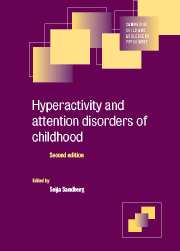Book contents
- Frontmatter
- Contents
- List of contributors
- Preface
- 1 Historical Development
- 2 Epidemiological aspects: what have we learned over the last decade?
- 3 Cross–cultural/ ethnic aspects of childhood hyperactivity
- 4 4 Sex differences and their significance
- 5 Classification issues
- 6 The role of attention
- 7 Cognitive aspects and learning
- 8 Developmental perspectives
- 9 Behavioural and molecular genetic studies
- 10 Biological underpinnings of ADHD
- 11 Psychosocial contributions
- 12 Institutional care as a risk factor for inattention/overactivity
- 13 Treatments: The case of the MTA study
- 14 Attention feficit hyperactivity disorder in adults
- Index
12 - Institutional care as a risk factor for inattention/overactivity
Published online by Cambridge University Press: 28 August 2009
- Frontmatter
- Contents
- List of contributors
- Preface
- 1 Historical Development
- 2 Epidemiological aspects: what have we learned over the last decade?
- 3 Cross–cultural/ ethnic aspects of childhood hyperactivity
- 4 4 Sex differences and their significance
- 5 Classification issues
- 6 The role of attention
- 7 Cognitive aspects and learning
- 8 Developmental perspectives
- 9 Behavioural and molecular genetic studies
- 10 Biological underpinnings of ADHD
- 11 Psychosocial contributions
- 12 Institutional care as a risk factor for inattention/overactivity
- 13 Treatments: The case of the MTA study
- 14 Attention feficit hyperactivity disorder in adults
- Index
Summary
Numerous clinical and epidemiological studies have shown substantial associations between a range of psychosocial adversities and attention deficit hyperactivity disorder (ADHD: Taylor, 1986; Taylor et al., 1991; Biederman et al., 1995; Scahill et al., 1999; Chapter 11). It is usually assumed that the associations represent the operation of environmentally mediated risk factors. This would seem to be justified on the basis that rigorous research designs have shown significant effects on psychopathology of features such as family negativity and conflict (Rutter, 2000a), and therapeutic interventions designed to reduce coerctive family interactions have been shown to bring about worthwhile benefits (Rutter et al., 1998). In recent times, attention has tended to shift away from the role of possible psychosocial influences in aetiology, because of the consistent finding that genetic factors account for a major part of the variation in individual liability to ADHD; that influence is probably greater than that for any other child psychiatric disorder other than autism (Tannock, 1998; Rutter et al., 1999; Thapar et al., 1999), and because of the huge body of evidence showing the benefits stemming from stimulant medication (MTA Cooperative Group, 1999a,b). Nevertheless, the genetic findings show that ADHD is a multifactorial disorder in which environmental as well as genetic factors play a role in aetiology. Also, there is some evidence that the best therapeutic results may come from multimodal interventions that include, but are not restricted to, medication (Taylor, 1999). Several difficulties have bedevilled attempts to identify specific psychosocial risk factors for ADHD.
- Type
- Chapter
- Information
- Hyperactivity and Attention Disorders of Childhood , pp. 417 - 434Publisher: Cambridge University PressPrint publication year: 2002



